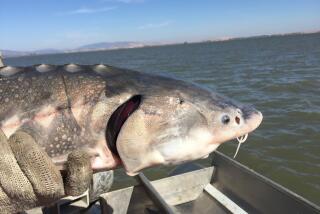Study Says Frog Habitat Won’t Hamper Builders
- Share via
The economic effects of designating more than 5 million acres in California as federal habitat for the red-legged frog will not require changes to most development projects except in Alameda and Contra Costa counties, according to a report released Thursday.
The report, by economists hired by the U.S. Fish and Wildlife Service, also predicts that a habitat designation for the frog will result in $9 million to $13 million in additional consulting costs over a decade, some of which will have to be paid by private landowners.
Builders and developers, long wary of additional government oversight, said the report doesn’t accurately represent the financial burden that a habitat designation would bring.
“They assume it doesn’t establish additional regulatory requirements,” said David Smith, general counsel for the Building Industry Assn. of Southern California, which has 1,800 members. “We reject that completely. It renders the economic analysis false.”
The habitat, which was proposed by Fish and Wildlife in September, would stretch across 31 California counties, from San Diego north to Tehama County.
Environmental groups sued the Fish and Wildlife Service to force creation of a habitat for the red-legged frog. Under the federal Endangered Species Act, the frog, federally listed as threatened, must have habitat designated for protection of the species.
“Fish and Wildlife had to be sued to list the frog and to designate critical habitat,” said Peter Galvin, of the Center for Biological Diversity, one of the groups that sued the federal agency.
“We do feel that critical habitat adds significant additional protections. But in terms of the economic report, we find that it greatly underestimates the economic benefits of the habitat like ecosystem health, real estate benefits and flood control.”
The red-legged frog, believed to be the same amphibian made famous in Mark Twain’s short story “The Celebrated Jumping Frog of Calaveras County,” is the largest native frog in the Western United States.
They are olive, brown, gray or reddish-black, with small black flecks, and are so-named because many have red or salmon-colored legs.
The economic report cites Alameda and Contra Costa counties as areas that may have to change development projects, because those areas have proposed habitat lands that are likely to face large-scale building in the future, said Edward Maillett, an economist with Fish and Wildlife.
In Ventura County, more than 340,000 acres are proposed for the habitat, including portions of Vandenberg Air Force Base, where the frogs are thriving.
In the case of Los Angeles County, where more than 390,000 acres are proposed for the frog habitat, including portions of property owned by Newhall Land and Farming, most impacts will be the extra consulting costs borne by developers, Maillett said.
But Marlee Lauffer, a spokeswoman for Newhall Land, said the designation, which would affect land east of the Golden State Freeway, “would add to both the delay in delivering houses and the cost of those future homes.”
The Fish and Wildlife Service will host a public meeting on the economic report Jan. 3 at the San Luis Obispo Embassy Suites from 1 to 4 p.m.
A final decision on the habitat proposal is expected by March 1.
More to Read
Sign up for Essential California
The most important California stories and recommendations in your inbox every morning.
You may occasionally receive promotional content from the Los Angeles Times.













